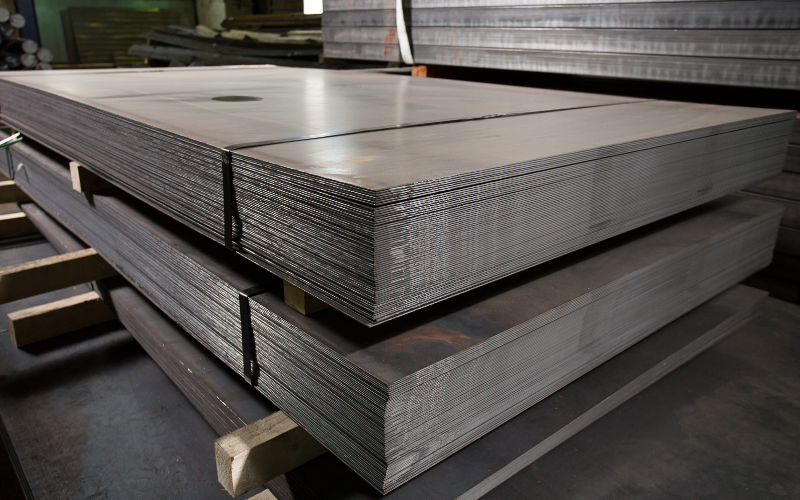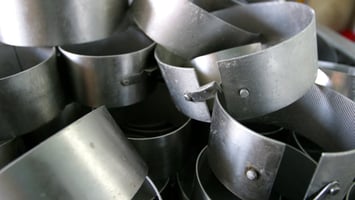Stainless steel is a popular choice for high-quality metal fabrication due to its durability,...
Kryton Metals Blog
Stainless Steel: Different Types, Processes, and Applications

Stainless steel is a widely used material in various industries, valued for its remarkable
resistance to corrosion and rust and its aesthetically-pleasing finish. However, not all stainless
steel is the same. Different grades and composition of stainless steel offer distinct properties
and benefits, making it vital to understand the differences when choosing the right material
for a fabrication job or a project.
HOW DOES IT WORK?
Stainless steels are special kinds of steel with better protection against rust compared to
regular steels. They have an added amount of chromium, which helps fight corrosion—while
other elements can also help prevent rust, chromium is the most important one for the job.
Stainless steel metal is made in an electric arc furnace, where carbon electrodes touch
recycled stainless steel scraps and chromium alloys. When electricity flows through,
temperatures rise until the scrap and alloys melt. Then, the melted mix is moved to an AOD
vessel to lower the carbon levels and adjust the alloy composition.
After that, it’s shaped into ingots or slabs, which are then hot rolled into their final shapes.
Some undergo cold rolling for further thickness reduction or are drawn into smaller
diameters. Most stainless steel gets a heat treatment to soften it and chemical wash to clean
its surface
SERIES & APPLICATIONS
Most stainless steels can be broken down into one of three different categories, each offering
their own level of quality, durability, and temperature resistance:
- Austenitic: Highly corrosion-resistant and non-hardenable by heat treatment. It contains 16-26% chromium and up to 35% nickel.
- Ferritic: Lower chromium content and lacks nickel. It does offer moderate corrosion
resistance but will develop localized rust over time and is commonly used in
architecture and auto trim. - Martensitic: Hardenable by heat treatment and contains 11-18% chromium and a
small amount of carbon. It is strong, ductile, and magnetic, finding applications in
cutlery, wrenches, and surgical equipment.
There are two other less common categories that aren’t mentioned as often. Duplex stainless
steel combines elements from both austenitic and ferritic stainless steel types, offering
strength greater than either alone. It contains 21-27% chromium, 1.35-8% nickel, and other
alloying elements, making it suitable for chemical processing and storage tanks. Precipitation
stainless steel contains 15-17.5% chromium, 2-5% nickel, and small amounts of aluminum,
copper, and niobium—it can be hardened by aging treatment. It provides excellent corrosion
resistance and is used for shafts and valve spindles.
GRADES
Within the three big categories mentioned above, there are also different grades of stainless
steel used for different applications. In austenitic stainless steels, you have your 200 and
300 series, where the two common grades are 304 and 316, known for their high tensile
strengths. When compared, grade 316 is more resistant to different chlorides (specifically
salt), meaning it does better against harsher elements, making it more desirable in maritime
applications.
Within ferritic stainless steels, there’s grade 430 and 434, which aren’t as strong as the
austenitic stainless steels but offer better resistance to nitric acid and are still plenty strong
for most heavy-duty applications.
Grade 420 belongs to the martensitic stainless steels, which offers slightly less resistance to
chemicals than the other two categories, but it still has decent resistance to things like alkalis,
milder acids, water, and food. Combine that with decent tensile strength and impact
resistance, and it becomes ideal for cutlery.
Here are some steel grade series and their applications:
- 200 Series: Automobile wheel covers, trims, kitchen equipment, hub caps, milk
handling - 300 Series: Railroad cars, trailer bodies, fasteners, household appliances, signs,
furnace parts, tanks for liquid fertilizer, ketchup cooking kettles, boiler shells, fire walls,
valve fittings - 400 Series: Jet engine rings, dry fertilizer spreaders, tanks for agricultural sprays, coal
chutes, rifle barrels, scissors, spindles, fire extinguisher inserts, rivets, vegetable
choppers, steam turbine blades, dishwashers, heaters, mufflers, aircraft fittings - 500 Series: Heat exchangers, gas (fuel) refining equipment, gaskets
Metal spinning, also known as spin forming or spinning metal, is a highly versatile process
widely utilized in industrial and agricultural sectors. Metal spinning companies specialize in
shaping materials like stainless steel, offering exceptional durability and corrosion resistance.
Using metal spinning tools, these companies can create intricate designs, including spun
metal cones, with precise shaping and forming capabilities.
The process yields components with a high strength-to-weight ratio, ensuring both
sturdiness and lightweight properties. Furthermore, spun metal surfaces of stainless steel are
known for their smoothness and polished finishes, enhancing both aesthetic appeal and
functionality.
ADVANTAGES
- Corrosion/Rust Resistance - Attributed to the addition of chromium, stainless steel’s
exceptional corrosion resistance has made it a widely-used material, with modern
variations like 316-grade stainless steel boasting additional resilience. - Fire/Heat Resistance - Stainless steel’s exceptional fire and heat resistance stem from
its inherent oxidation resistance, particularly at elevated temperatures, attributed to
chromium content, which allows it to maintain its strength in harsh and extreme
temperatures. - Hygiene - Stainless steel’s hygienic advantage lies in its effortless cleaning and
sanitization properties, facilitated by its smooth, non-porous surface that resists the
buildup of dirt, grime, and bacteria, ensuring ease of maintenance and adding
long-term value. - Impact Resistance - Coupled with high impact resistance and low susceptibility,
stainless steel’s exceptional toughness and durability makes it suitable for diverse
applications, including manufacturing and cryogenic uses. - Aesthetics - Stainless steel's enduring popularity lies in its elegant, modern
appearance, often perceived as a symbol of purity, versatility, and timeless aesthetic
appeal, seamlessly blending with various architectural styles and color schemes. - Sustainability - Stainless steel stands out as a sustainable option, crafted mainly from
recycled scrap metal and fully recyclable without leaching harmful substances, thus
reducing the demand for mining rare elements.
WRAPPING UP
Overall, understanding the differences between stainless steel grades and applications helps
businesses and manufacturers to make better decisions based on their specific needs and
requirements. By leveraging the right combination of stainless steel components, projects
can achieve optimal performance, durability, and cost-effectiveness, ensuring long-term
success and satisfaction.
Want to learn more about stainless steel or interested in requesting a quote? Click here to get
in touch with us!



